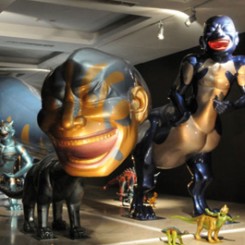Since then however, it appears Yue has been hoist with his own petard – appropriate really given the hot air involved. Umpteen leering self-portraits have continued to roll out with only two real exceptions, one unsuccessful, one pointing to an interesting potential future. First came, “Landscapes With No One,” from 2006 and this year the subject of the exhaustively titled exhibition, “The Spirit Scenes from Time Past – Yue Minjun Solo Exhibition of Paintings Series: ‘Landscapes with No One,’” at Shanghai Gallery of Art. These involve realistic tableaux paintings of famous propaganda scenes and Western works, only absent the protagonists – the subject of a recent show at Shanghai Gallery of Art. Inspired by the famous girl-on-girl portrait “Gabrielle d’Estrées and One of Her Sisters,” 1594, depicting the former tweaking the nipple of the latter, Yue’s version shows just an empty room with a gaping bath downstage. Another example is Delacroix’s “Women of Algiers in their Apartment,” 1834. In Yue’s version (2006) the remains are a hookah pipe and lavish soft furnishings straight from Homes & Gardens, only not as sumptuous as Delacroix’s. This is a general problem. Not only is the scale higgledy-piggledy, with some paintings much larger than their model, some less, none of identical size, but the actual painting technique is relatively slapdash. And in this context the quality is important, because it means the conceit fails to convince, let alone seduce, thus depriving it of its all-important disguise. The re-workings of propaganda paintings suffer similarly although their content sometimes manages to deliver something more substantive. So in “I Graze Horses for My Motherland” (2006) the horses are freed of their riders, and, absent its brave soldiers. “Eulogy of the Yellow River” (2006) becomes a picture about cranes sweeping over the river. Meanwhile, “Take the Luding Bridge by Storm” (2006) and “Seizing the Presidential Palace” (2006) are no longer heroic and inspiring but tragic and mournful. But “Tian An Men Remains,” free of Mao, dignitaries and euphoric crowds, remains grandiose rather than poignant. Meanwhile, “Chairman Mao Visits Canton Countryside” looks like a student wanting to do a really, really big Van Gogh, but muffing it.
This is more or less the same territory as the photography of German artist Thomas Demand, where mass-culture images of psycho-trauma derived, for instance, from infamous events of Fascism, terrorism and extreme criminality, are repositioned as empty stages. Demand’s game however is considerably subtler. Whereas Yue relies on a new conceit, Demand’s art is in the methodology, the absent friends merely a foil for investigating the semiotic and evidential nature of public images versus personal memory. The question is whether there is a particular ‘Chinese’ context that nevertheless justifies Yue’s relatively simplistic gambit. Unlikely. The scale of a ‘trauma’ should not justify a reductive approach. Arguably the more complicated the history, and the more talented or prominent the artist, then the higher the standard of intellectual rigor and care that is required to critically address historical events. In this case, the method itself is ham-fisted. Yue Minjun simply does not match Demand’s care. Demand first constructs a scene in paper; such as the studio of an artist who was targeted by Baader-Meinhof terrorists in order to assassinate the neighbouring state prosecutor (“Attempt”, 2005) or the rumoured assassination of a German politician (“Badezimmer (Beau Rivage)”, 1997). This is then photographed, apparently recreating precisely the ‘original,’ but the copy is disturbingly clean and lacking in detail. Finally, the paper model is destroyed – the photographic evidence becomes a simulacrum and what we think we see is only what we expect to.
